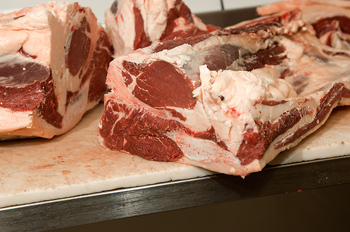Dry Aged Vs. Wet Aged
 There is always some discussion about how to prepare your meat – is it dry aged or wet aged?
All meat has to have a cool-down period to get the temperature down,
not just in Missouri. There is a minimal delay needed from the time the
live beef is delivered and the wrapped, frozen packages are ready for
pick-up and delivery.
There is always some discussion about how to prepare your meat – is it dry aged or wet aged?
All meat has to have a cool-down period to get the temperature down,
not just in Missouri. There is a minimal delay needed from the time the
live beef is delivered and the wrapped, frozen packages are ready for
pick-up and delivery.Meat should be aged before it is cut and wrapped. This increases tenderness.
I found this PDF called "Beef and Part Whole Animal Buying Guide" from the Iowa State University Extension, which says:
Beef Aging
Aging, measured in days, refers to the time from when the animal is
slaughtered to when the beef carcass is broken down into retail cuts.
Beef purchased directly from farmers or ranchers and processed by a
local butcher will typically be “dry aged,” meaning the carcass will
hang in a walk-in cooler while aging. “Wet aging” is a process used to
age wholesale beef cuts in vacuum packaging and not often used by
smaller-scale meat processors.
Dry aging beef does three things:
Dry aging beef does three things:
1. Improves meat tenderness
2. Increases “beefy” flavor
3. Causes meat to lose weight through evaporation
...Additionally, beef that is "hanging" takes up the butcher’s limited
cooler space, so you can expect to pay a fee for additional aging. The
desirability of the increased beefy flavor that develops through
extended aging is purely personal preference. Aging beyond 28 days may
result in off flavors. Confirm with your butcher how long your beef
carcass will be aged.
As a general rule, younger animals will be more tender than older animals and fatter animals will be more tender than leaner animals.
As a general rule, younger animals will be more tender than older animals and fatter animals will be more tender than leaner animals.
Wet aging is simply cutting and wrapping the beef in air-tight plastic immediately. This is used by corporate processors, as it tends to preserve the color. As well, it takes up much less locker space. Some beef has been anecdotally reported to be "aged" as it's shipped from plant to plant. Some plants deal with the live animal, then cut and seal the "primals", which are then loaded onto trucks.
These primal cuts are shipped to other plants which can deal with rendering them into smaller cuts, as well as packaging them for various food store chains. Finally, it's shipped to your local supermarket, where it finishes it's "aging" in the display case - sometimes less than a week from the time it was a live animal.
The processors we use do not use wet-aging.
We use traditional dry aging, hung in lockers and then parted out. These are then sealed in plastic and frozen to preserve their flavor and quality.
Our experience is that wet-aging simply doesn't result in the best-tasting meat. Along with the corn-fed diet, beef can wind up quite bland through this quick-aging process.
Grass fed beef, properly dry-aged, is a delight to eat - both tastier and healthier for you.








No comments:
Post a Comment